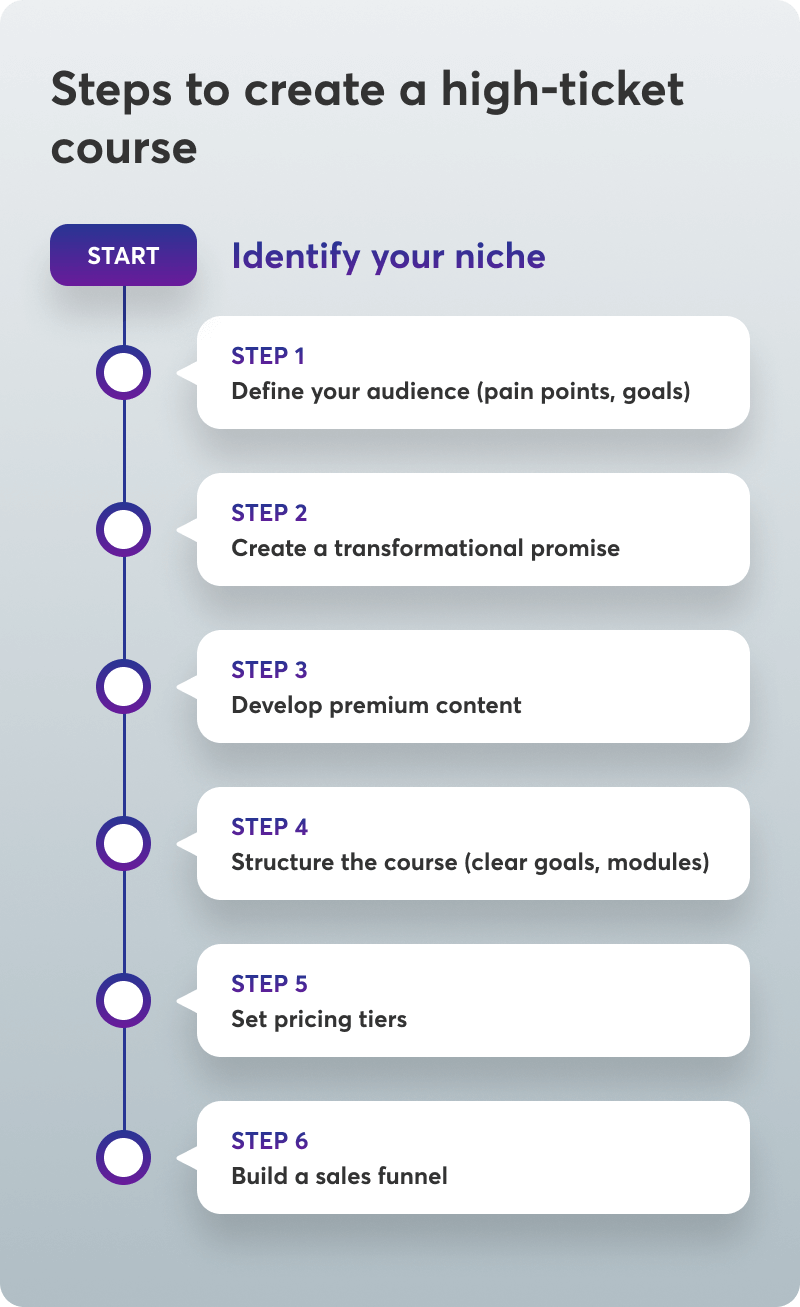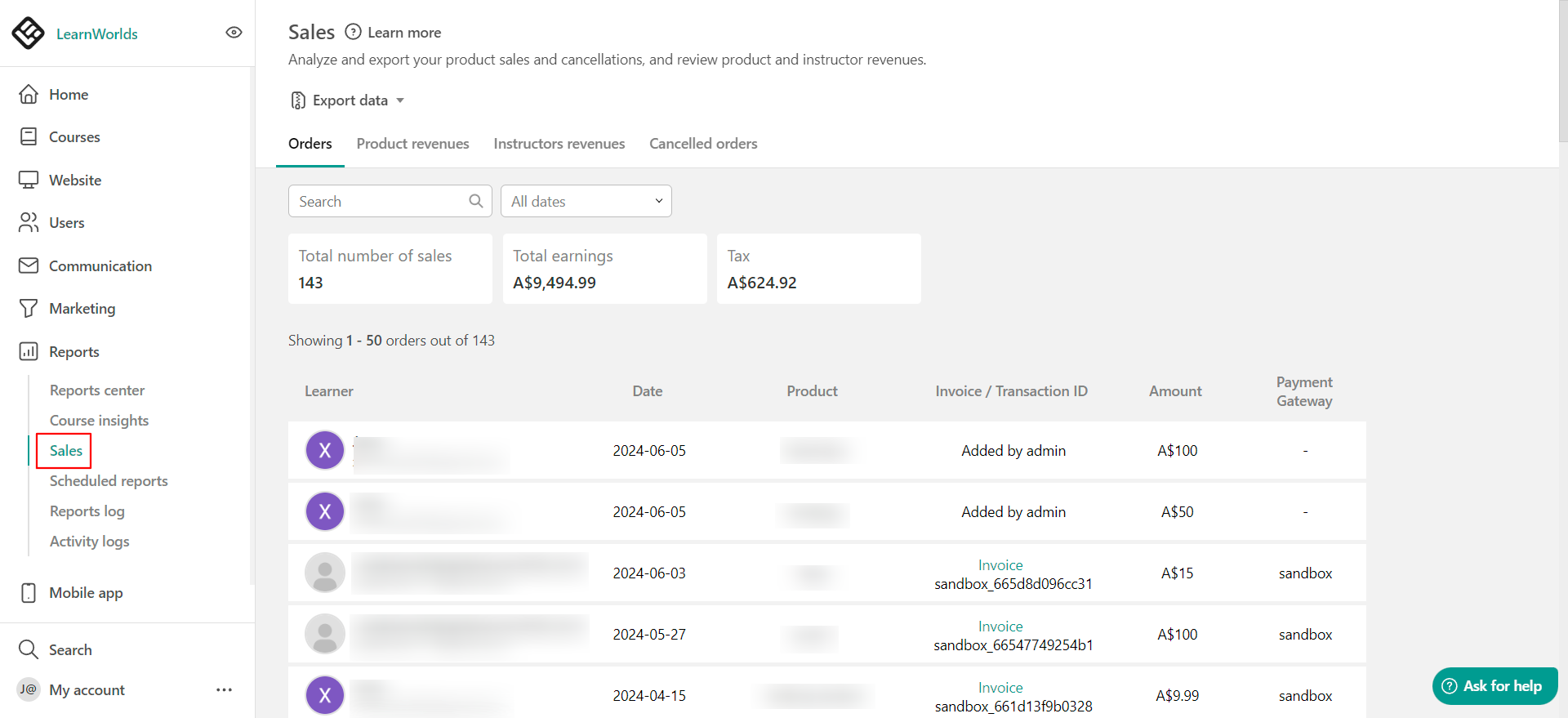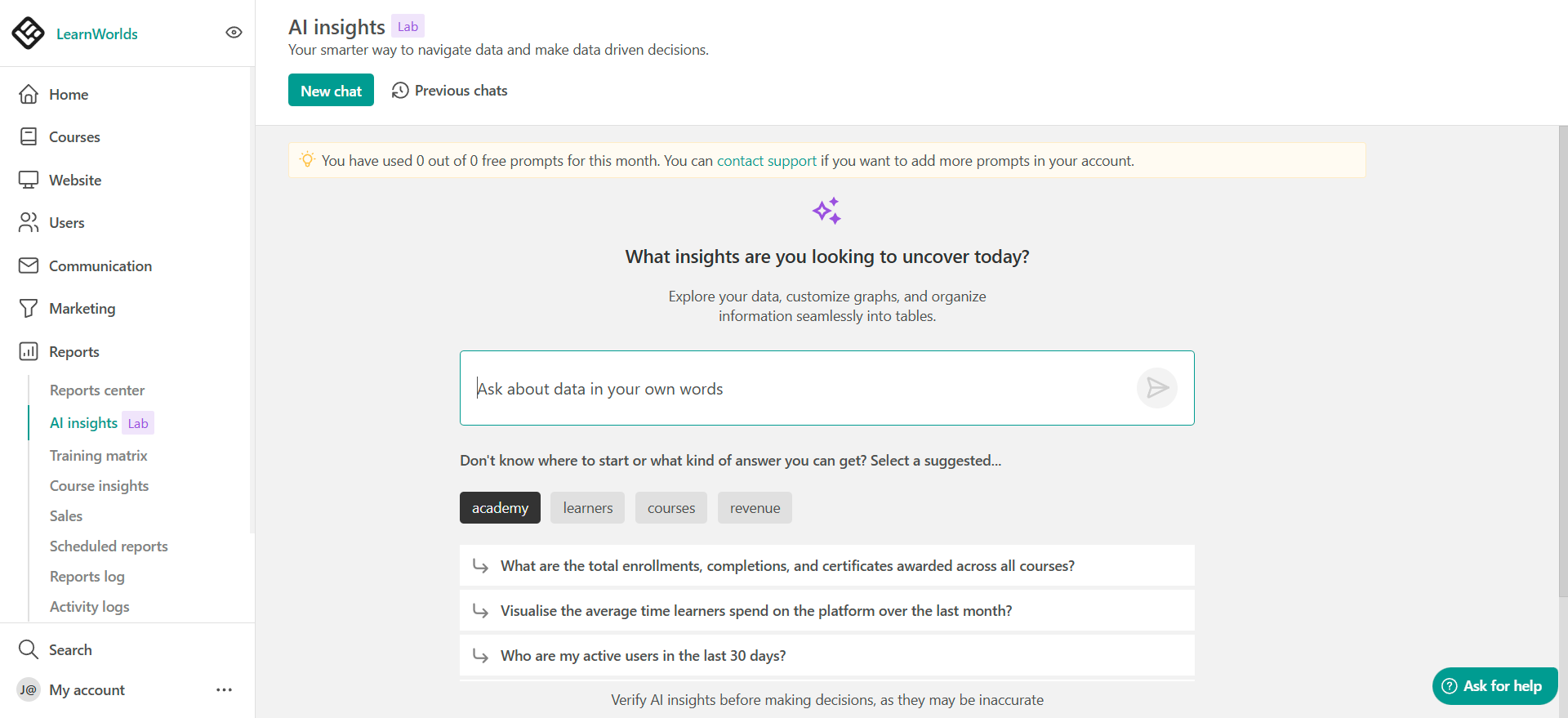Sell high ticket courses and maximize your revenue: a step-by-step guide
Imagine this: You’re walking into a store. On one side, there’s a display of budget items, piled high, catering to everyone. On the other side, there’s a sleek glass case showcasing an exclusive, premium product—something that screams “luxury,” “value,” and “transformational experience.” Now ask yourself, which side of the store do you want your online course to belong to?
Welcome to the world of high ticket courses—the equivalent of the premium product behind that glass case. These aren’t just courses; they’re tailored, transformative learning experiences that position you as a leader in your niche. If you create high ticket courses, you can significantly scale your business by offering these exclusive, high-value programs.
But what makes them so distinct, and why are they worth considering for your business? Let’s dive in.
What is a high ticket course?
At its core, a high ticket course is an online educational product priced above $900, and often far beyond. But it’s not the price alone that defines it; it’s the value delivered.
A high ticket course generally has the following characteristics:
Dives deep: it goes beyond surface-level content, offering comprehensive insights that genuinely move the needle for learners
Prioritizes personalization: with components like coaching calls, direct access to instructors, or custom feedback, a high ticket course creates a tailored experience
Focuses on outcomes: designed to solve specific, high-stakes problems, it empowers learners to achieve life-changing results
Demands excellence: a high ticket course is polished, professional, and backed by the expertise of its creator
Exudes exclusivity: it caters to a select audience willing to invest in premium education.
What are the key benefits of creating a high ticket course?
Crafting a high ticket course isn’t just about charging more—it’s about creating a product that transforms both your learners’ lives and your business. When you create high ticket courses, you establish a powerful business model that can significantly scale your business. Here’s how:
Scale with impact: Instead of chasing thousands of enrollments, high ticket courses allow you to focus on fewer learners while maintaining, or even exceeding, your revenue goals. This means more time to deliver quality and build meaningful relationships with your learners.
Financial freedom: By shifting from low-margin to high-margin products, you maximize the potential to grow your income sustainably, therefore securing resources to scale your business or explore new ventures.
Drive student success: High ticket pricing often attracts serious learners who are ready to take action. Combined with the personalized support you provide, such as coaching sessions or group calls, this leads to better results, glowing testimonials, and word-of-mouth referrals.
Reputation building: High ticket courses elevate your brand’s perception. They position you as a thought leader, making your name synonymous with high-quality, results-driven education.
What differentiates a high ticket course from a low ticket course?
While low ticket courses cater to a broad audience with bite-sized, introductory content, high ticket courses play a different game entirely.
High ticket courses are designed to offer a more comprehensive, in-depth, and personalized learning experience, making them a distinct business model in the online education market.
Feature
High ticket courses
Low ticket courses
Price point
$900+
$10–$200
Audience commitment
Motivated, action-oriented
Casual learners
Content depth
Advanced, specific, and tailored
Introductory, general
Support level
Extensive (eg, coaching, feedback)
Minimal (if any)
Revenue potential
Value-based
Volume-based
High ticket courses
Low ticket courses
Price point
$900+
$10–$200
Audience commitment
Motivated, action-oriented
Casual learners
Content depth
Advanced, specific, and tailored
Introductory, general
Support level
Extensive (eg, coaching, feedback)
Minimal (if any)
Revenue potential
Value-based
Volume-based
By creating a high ticket course, you step away from competing in crowded markets where price wars dominate and move into a space where quality, trust, and value reign supreme. High ticket courses benefit more from personalized sales calls compared to traditional sales pages.
Why a high ticket course is your next big move
Imagine shouting into a crowded room, struggling to be heard amidst the noise. Now, picture this instead: an intimate gathering where every person is engaged, attentive, and eager to learn from you. That’s the essence of creating a high ticket course—a strategic choice to prioritize depth over breadth, relationships over reach, and transformative value over your sales process.
High ticket courses can help you increase your monthly revenue and foster a tight-knit community of people.
Selling high ticket online courses is a great way to make a lot more money for the awesome content you create, and it’s more than that. It allows you, as a course creator, to focus more on the people you’re bringing together and provide your business more resources.
Clearly, high ticket courses are your ticket to standing out. They’re not just high ticket products—they’re experiences. So, keep in mind that creating a high ticket course isn’t just about pricing higher, it’s about creating a sustainable, impactful business model with real results where both you and your students thrive.
And with LearnWorlds, creating and delivering these premium offerings becomes not only possible but effortless. In this article, we show you how.
What do you need to create a high ticket course?
You need to focus on three key pillars: resources, perception, and connection.
More resources, less noise
When you create a high ticket course, you’re not aiming to cater to everyone—you’re speaking to a specific, highly motivated audience. This strategic focus brings invaluable advantages:
Smaller, more engaged audience
Forget chasing numbers. A high ticket course lets you keep your student base intimate and manageable. This ensures you have the bandwidth to offer personalized guidance and truly connect with your learners.
Focused quality
Without the pressure of handling a massive audience, you can dedicate your time and energy to perfecting your course materials, delivering unparalleled value and making each student feel seen and supported.
Stronger community
A smaller cohort doesn’t mean less impact—in fact, it’s the opposite. You have the chance to foster meaningful connections within your group, creating a collaborative and supportive learning environment.
Perceived value and prestige
Value is about more than just content—it’s about the outcomes you help your students achieve and the way you position your course in the market:
High pricing reflects high value
Most people equate price with quality. A high ticket course signals that what you’re offering is transformative, exclusive, and worth their investment.
Position yourself as an expert
When learners enroll in your course, they’re trusting you to guide them toward real results they couldn’t achieve on their own. This positions you as an expert in your field, elevating your brand reputation.
Foster loyalty and community
High ticket courses naturally attract committed learners. Instead of trying to keep them engaged with constant new content, you create a strong community that sustains itself and amplifies your course’s value through shared success.
Commitment to excellence
To create a high ticket course, you need to approach the process with precision and purpose:
A clear, transformational promise
Define the specific results your course and programs will deliver to your clients (be it new skills, certifications, coaching, mentoring, and so on). Your promise should be bold yet achievable, giving learners a compelling reason to enroll.
Tailored learning experiences
Offer personal support like coaching, Q&A sessions, or individualized feedback. These elements add a layer of exclusivity and ensure that students feel valued.
Premium content and delivery
High ticket courses demand high-quality content. Use a mix of videos, workbooks, live sessions, and community interaction to create an engaging and effective learning journey.
How to identify your target audience for a high ticket course
A high ticket course isn’t for everyone—it’s for a select group of people who are ready to invest in themselves and achieve transformative results. The key to success? Understanding exactly who they are and what they need.
Here are the three key steps you need to take to identify and connect with your ideal audience.
Step 1: understand your ideal customer
Your high ticket course is only as effective as its ability to solve real problems for your audience. Start by answering these critical questions:
Who are they? Define the specific demographics of your ideal customer: age, profession, income level, education, and lifestyle.
What do they want? Pinpoint the goals and aspirations that drive them. What outcomes are they looking to achieve?
What’s holding them back? Identify the challenges, frustrations, or barriers preventing them from reaching their goals. These pain points are the problems your course should solve.
Step 2: research their needs and pain points
The more you understand your audience’s struggles, the better equipped you’ll be to create a course that delivers real value. Use these strategies to uncover insights:
Conduct surveys and interviews
Go straight to the source—ask your potential learners what they’re struggling with and what kind of support they’re seeking. Online surveys, email polls, and one-on-one interviews are all effective.
Analyze online feedback
Dive into online reviews, social media discussions, forums, and niche communities. Look for recurring themes and complaints to identify gaps your course can fill.
Host focus groups
Gather a small group of your target audience to discuss their needs, expectations, and desired outcomes. This qualitative feedback can be a goldmine for shaping your course.
Step 3: create buyer personas
Buyer personas help you humanize your audience and create a clear picture of who you’re speaking to. Here’s how to build one:
Demographics: Define age, gender, education, occupation, and location
Goals and motivations: Identify what drives them—both personally and professionally
Pain points: Detail the challenges or obstacles they’re facing that your course can solve
Preferred learning style: Understand whether they prefer video, written content, live sessions, or community interaction
Example persona: Meet Mary, a 35-year-old marketing professional aiming to transition into leadership roles. She struggles with mastering advanced analytics and presenting data-driven strategies to C-suite executives. Mary prefers self-paced courses with downloadable resources and occasional live Q&A sessions.
How to choose a profitable niche for your high ticket online course
The ideal niche for your high ticket course exists at the intersection of market demand, your expertise, and your audience’s willingness to pay. To find this sweet spot, ask yourself three key questions:
Is there clear evidence of demand for this skill or solution? Research online trends, social media, and industry reports to identify niches with high demand. Also, analyze competition and market trends to determine the potential for profitability.
Can you offer something unique to stand out in the market? Conduct surveys, interviews, and focus groups to validate your niche idea and ensure there is demand for your high ticket course. Also, analyze online reviews, social media, and forums to identify common challenges and concerns in your niche.
Does this niche have long-term growth potential, or is it just a fleeting trend? Conduct competitor research to identify gaps in the market and areas for differentiation. Additionally, analyze market trends and forecasts to determine the potential for growth and profitability.
With these insights at hand, you can ensure your course not only resonates with learners but also remains profitable and impactful over time.
How to create a high ticket online course
Building a high ticket online course is about more than just assembling information—it’s about crafting an exceptional learning experience that delivers transformational results.
Here’s how to structure, differentiate, and enhance your course to ensure it stands out and commands a premium price.
Structuring your course content
The foundation of your course lies in its structure. A clear and organized outline helps your audience navigate the material and reinforces the value of your offering.
Start with the end goal
Define the specific outcomes your learners will achieve by the end of your course. What transformation or skill will they gain?
Map out your curriculum
Break the journey into logical steps or modules that build on each other. Each module should have a clear objective and actionable takeaways.
Simplify without sacrificing depth
Focus on delivering concise, impactful lessons without overwhelming learners with unnecessary content. Prioritize clarity and progression.
Developing a unique selling proposition (USP)
Your unique selling proposition is the heartbeat of your high ticket course—it’s what sets you apart in a crowded market and convinces learners to invest.
Identify unique benefits and features
What does your course offer that others don’t? Think beyond the content itself—consider exclusive access to you, personalized feedback, or proprietary frameworks.
Understand your target audience
Tailor your USP to address the specific challenges and goals of your ideal learners. Speak directly to their pain points and aspirations.
Communicate your value clearly
Your USP should be concise, compelling, and easy to understand. For example: “Master the art of data storytelling with our 8-week personalized program designed for marketing professionals.”
Creating engaging and valuable content
High ticket courses demand high-quality content that captivates and empowers learners. Here’s how to deliver:
Diverse content formats
Cater to different learning styles by including a mix of videos, audio, worksheets, and quizzes. This keeps learners engaged and enhances knowledge retention.
Interactive and actionable lessons
Include opportunities for learners to apply what they’ve learned through exercises, real-world projects, or discussions. Active engagement drives results.
Focus on value over volume
High ticket learners value depth and impact over sheer quantity. Deliver actionable insights and transformational strategies that make every minute of their time worthwhile.
Pricing strategies for high ticket sales
Pricing a high ticket course isn’t just about picking a number—it’s about strategically positioning your course to reflect its value, attract the right audience, and maximize your revenue. Here’s how to craft a winning pricing strategy.
Calculating the value of your course
The foundation of your pricing strategy lies in understanding and articulating the value your course provides:
Focus on results and benefits
High ticket pricing is justified by the transformation your course delivers. Define the specific outcomes learners will achieve, whether it’s career advancement, business growth, or a personal breakthrough.
Research the competition
Study how similar courses in your niche are priced. Look at what they offer, how they deliver value, and where you differentiate to justify your price point.
Align with market trends
Stay informed about industry trends and the willingness of your target audience to invest in premium education. This ensures your price remains competitive while reflecting the unique value you provide.
Offering tiered pricing options
Tiered pricing helps you cater to a wider audience without compromising the exclusivity of your high ticket offering:
Basic tier
Offer access to core content at a lower price point for learners who don’t require additional support.
Mid-level tier
Include added benefits like group coaching, live Q&A sessions, or bonus resources.
Premium tier
Provide the full experience, such as one-on-one coaching, exclusive content, or lifetime access. This tier should deliver maximum value and command the highest price.
Examples:
Basic: $900 – Core course materials
Mid-level: $1,500 – Core materials + group coaching
Premium: $2,500 – Core materials + group coaching + personalized coaching
Strategies for pricing your course
Use proven pricing techniques to enhance perceived value and encourage enrollment:
Anchoring
Introduce a high-priced option first to set a reference point, making other tiers seem more affordable in comparison. For instance, if your premium tier is $3,000, your mid-tier at $1,500 will appear more accessible.
Bundling
Combine related offerings, like bonus workshops or downloadable templates, into a package deal. Bundles create the perception of getting more value for the price.
Scarcity
Use limited-time offers or exclusive enrollments to create urgency. “Only 20 spots available” or “Early-bird pricing ends soon” can motivate quicker decisions.
Transparency
Be upfront about what’s included at each price point. Clear communication builds trust and ensures your audience understands the value they’re paying for.
Social proof
Make sure to justify your price. Use testimonials, case studies, and success stories to demonstrate the value of your course. Highlight the return on investment learners can expect.
Be aware that a successful pricing strategy not only convinces learners to enroll but also ensures they feel confident in their investment. So, make it easy to understand. Clearly outline what learners get at each price level. Avoid overly complex pricing structures that could confuse or deter potential students.
Last but not least, adjust your pricing strategy based on feedback. After launching, collect feedback on your pricing. If learners perceive your course as underpriced or overpriced, consider making adjustments for future iterations.
Marketing your high ticket course
A successful high ticket course isn’t just about the content—it’s about how you market it. Building excitement, guiding potential customers through a seamless sales journey, and leveraging powerful marketing channels are key to maximizing your enrollments.
Here’s how to market your high ticket course effectively.
Building anticipation and excitement
The journey to selling your high ticket course begins long before the launch. Creating buzz and anticipation can drive demand and make your course an event people don’t want to miss.
Pre-launch sequence
Develop a pre-launch plan that includes teaser content, behind-the-scenes looks, or countdowns. Use email marketing, social media, and content marketing to drip valuable insights related to your course topic, positioning yourself as an expert while building anticipation.
Engage your audience
Host live Q&A sessions, webinars, or challenges to give your audience a taste of what your course offers. These events create excitement and a sense of urgency.
Use scarcity and exclusivity
Offer early-bird access, limited spots, or special bonuses for those who enroll early. Creating a sense of scarcity can encourage quicker decisions and increase perceived value.
Creating a sales funnel
A strong sales funnel is essential for guiding potential students from awareness to enrollment. Each stage of the funnel should build trust and highlight your course’s value.
Awareness stage
Use blog posts, social media content, and paid ads to attract your target audience. Focus on addressing their pain points and showcasing your expertise.
Consideration stage
Offer free resources like eBooks, webinars, or mini-courses in exchange for email addresses. This allows you to nurture leads and demonstrate the value of your course.
Decision stage
Use personalized strategies like sales calls or tailored email sequences to address individual concerns and highlight how your course aligns with their goals.
Close the sale
Create a compelling, easy-to-navigate sales page with testimonials, case studies, and clear calls-to-action to convert interested leads into paying customers.With LearnWorlds, creating a professional and effective sales page is a walk in the park. Our platform offers intuitive tools like pre-designed templates, a drag-and-drop editor, and built-in analytics, empowering you to showcase your courses and attract more students effortlessly.Whether you’re looking to highlight testimonials, present case studies, or craft compelling calls to action, LearnWorlds provides everything you need to convert interested leads into paying customers.To create a compelling, easy-to-navigate sales page for your LearnWorlds school, follow these steps:
Choose a clean layout by selecting one of LearnWorlds’ pre-designed templates that prioritize simplicity and ease of navigation. Customize the layout to align with your branding, ensuring a visually appealing design that draws attention to key sections.
Highlight testimonials and case studies by using the drag-and-drop editor to create sections showcasing success stories, customer reviews, and case studies. Include authentic quotes and metrics that emphasize the transformative impact of your course offerings.
Craft clear and persuasive calls to action by placing strategic buttons throughout the page, such as “Enroll now,” “Learn more,” or “Get started today.” Ensure each button stands out with contrasting colors and leads visitors to the next step in their journey.
Include engaging media, such as high-quality images, promotional videos, or demo clips of your courses, to give prospective customers a glimpse of the value they’ll receive.
Focus on benefits over features by writing compelling copy that addresses your audience’s pain points and highlights the outcomes they can achieve through your courses.
Optimize for mobile and SEO to ensure the sales page is mobile-friendly and uses relevant keywords to improve search engine visibility and reach a broader audience.
Test and iterate using LearnWorlds’ analytics tools to monitor visitor behavior and conversion rates. Continuously refine your page based on data insights for maximum effectiveness.
Leveraging email marketing and social media
Email and social media are two of the most powerful channels for connecting with your audience and driving sales.
Email marketing
Build an email list by offering valuable lead magnets. Then, nurture your subscribers with a mix of educational content, success stories, and exclusive offers. Segment your list to tailor your messaging to different audience segments, such as warm leads or past buyers.
Social media marketing
Use platforms like Instagram, LinkedIn, or Facebook to create a sense of community around your course. Share testimonials, success stories, and educational posts that demonstrate the value of your course. Engage with your audience through comments, live sessions, and direct messages.

Measuring success and ROI
The success of your online courses extends far beyond enrollment numbers. To achieve long-term profitability and lasting impact, it’s crucial to track key metrics, evaluate student outcomes, and use data-driven strategies to continuously refine your approach.
Here’s how to measure your course’s success and ROI effectively.
Tracking key metrics and analytics
Tracking the right metrics is essential for understanding your course’s performance and identifying areas for improvement.
Keep a close eye on the total revenue and number of enrollments. Compare these against your goals to assess whether your pricing model and marketing campaigns are meeting expectations.
High revenue with low enrollments may validate your high ticket strategy, while low revenue suggests room for adjustment.
If you build your online school with LearnWorlds, you can easily track your sales and revenue by navigating to the Reports Center. Here, you can access financial reports detailing total revenue and the number of enrollments over specific periods. This allows you to assess whether your pricing model and marketing efforts are successful.

Student engagement
Engagement is a direct indicator of how effectively your content resonates with students. Analyze lesson completion rates, time spent on individual modules, and attendance in live sessions.
High engagement typically correlates with greater student satisfaction and success.
With LearnWorlds, you can track student engagement from the course insights sections of the robust Reports Center to view metrics such as lesson completion rates, average study time, and social interactions. These insights help determine how effectively your content resonates with students.
Conversion rates
Your conversion rate reflects how well your sales funnel turns prospects into paying students.
A low conversion rate might signal issues with your messaging, the perceived value of your course, or your audience targeting.
Customer acquisition cost (CAC)
Calculate your CAC by dividing your total marketing and advertising spend by the number of students acquired. A manageable CAC-to-revenue ratio is crucial for sustaining profitability.
If your CAC is high, consider revisiting your marketing channels and strategies.
Using tools like AI Insights alongside LearnWorlds’ robust built-in analytics, you can gain a comprehensive understanding of your online school’s performance and take actionable steps to optimize ROI and student outcomes.
Adding to the above, the LearnWorlds AI Insights tool takes reporting to the next level. This advanced feature streamlines data analysis, making it faster and more efficient. It enhances your existing reports by providing quick access to crucial data insights. With its intuitive AI interface, you can explore metrics such as learner performance, course statistics, and revenue trends in just a few clicks.

Evaluating student success and feedback
Nothing signals the effectiveness of your course like the success of your students. By assessing their outcomes and gathering honest feedback, you can refine your course to deliver even greater value.
Here’s how to evaluate student success and leverage feedback for continuous improvement.
Measure your student’s success
Identify how well students are achieving the goals your course promises. Metrics like skill acquisition, career advancements, or business growth can help quantify success.
Consider incorporating tools like quizzes, assignments, or post-course assessments to gauge their progress. You can use LearnWorlds assessment builder to make this easy for you and engaging for your learners.
Collect testimonials and success stories
Reach out to students who’ve achieved outstanding results to document their transformation. These stories not only validate your course’s impact, but can also become powerful marketing assets.
Conduct surveys and polls
Use surveys to ask students about their experience with your course. Questions could focus on the clarity of the content, the relevance of materials, and their overall satisfaction.
You can also conduct one-on-one interviews with a selection of students to gain deeper insights into what worked well and where they faced challenges. This qualitative feedback is invaluable for making meaningful improvements.
And you can always observe the conversations within your course’s community or forums. Learners often share unfiltered opinions and suggestions in these spaces.
Overcoming common challenges
Creating and delivering a high-ticket course comes with its share of challenges, but each obstacle is an opportunity to grow and refine your approach.
One common hurdle is managing your time and workload. Balancing content creation with delivery can feel overwhelming, but the key is prioritizing high-impact activities.
Outsource tasks and delegate responsibilities wherever possible, freeing up time to focus on what truly matters—designing a transformative learning experience for your students.
Another challenge is overcoming the fear of selling, which can hold many course creators back. Shift your mindset by focusing on the value and life-changing benefits your course provides to students.
Sales scripts and templates can help you navigate conversations with confidence, making the process smoother and more comfortable. Remember, selling isn’t about pushing—it’s about connecting your audience with a solution they genuinely need.
Finally, dealing with criticism and feedback can be daunting, but it’s one of the most valuable tools for growth. Embrace feedback as a roadmap for improvement, using it to refine your course and enhance its impact.
Create a structured feedback system to gather input from students and continually optimize your offering. Each challenge you overcome brings you closer to building a high-ticket course that stands out and delivers exceptional value.
Start building your high-ticket course today
Creating a high-ticket course is more than a revenue strategy—it’s a way to deliver transformative value to your learners while scaling your business with purpose and precision. By focusing on personalization, exclusive content, and exceptional outcomes, you position yourself as a leader in your niche, fostering deeper connections with your audience and enhancing your brand’s reputation.
Throughout this guide, we’ve explored the key benefits of high-ticket courses, from scaling your revenue to building a strong community. You’ve learned how to identify your ideal audience, craft engaging content, and market your course effectively. Now, it’s time to take the leap.
Remember, the path to success begins with action. Use the insights shared here to create a course that not only drives profitability but also empowers your students to achieve life-changing results. With the right focus, strategy, and tools—like LearnWorlds—you have everything you need to build a high-ticket course that stands out in today’s competitive market.
So, what are you waiting for? Start creating your high-ticket course today with a LearnWorlds 30-day free trial, and take the first step toward maximizing your impact and income. The world is ready for the expertise you have to offer.
(Visited 4 times, 4 visits today)
Rosemary is LearnWorlds’ Content Marketing Manager. She has over 2 decades of experience in omnichannel marketing and content writing for the IT and SaaS industry. Her expertise lies in crafting effective content marketing strategies that attract, engage, and nurture customers, enabling LearnWorlds to reach its target audiences with precision.




